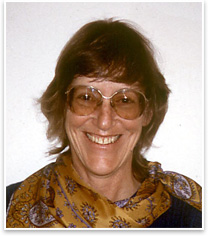
Edith Cherry, FAIA
Occupation: Architect, Landscape Architect, Professor Emerita at the University of New Mexico Firm: Cherry/See/Reames Architects Education: B.A. cum laude, BArch, and MArch from Rice University; graduate work in cultural anthropology at the University of New Mexico Favorite Book: The Nature of Prejudice by Gordon W. Allport Place you’d most like to visit: I’ve been wanting to go to Florence to see Brunelleschi’s dome, but there are a lot of other places I’d like to go, too. Most inspiring structure: A few years ago we went to Milwaukee and saw Santiago Calatrava’s addition to the Milwaukee Art Museum. It’s really wonderful. Describe your work in one sentence: It’s mostly public sector work: schools, libraries, community centers, plus historic preservation projects. I also do programming consulting, but that’s more than one sentence. Why you became an architect: I had never heard of architecture when I was growing up. I had never heard of an architect, but I liked art, science, math, and working with people. When I went off for my freshman year in college, I was studying commercial art, but I wanted something more. A friend of my older sister’s said, “You ought to try architecture.” I tried it for a year and just fell in love with it. That was 1959, so I’m still satisfied with my decision. Greatest professional reward: That’s tough. We do a lot of schools, and I love seeing kids enjoy the spaces that we’ve designed. Also, I was very honored to become a Fellow of the AIA, so I guess that was the highpoint. Key issue facing the profession: I think we all—or at least architects who weren’t around and practicing in the ’70s—need to become educated about resource conservation. I’m hoping that this time around there won’t be a lapse of that information. I think many of us continued to practice with conservation in mind between the ’70s and now, but there’s a whole generation that wasn’t around for that first time, and we need to make our buildings more resource conservative. Clients, especially public-sector clients, are starting to demand it. I think that the training and green building movement is going to have an impact. Dream project: It would have to involve people. It would be a place to enrich people’s lives and would have an educational component: a school or a museum or some sort of experimental playground. It would have to add something to people’s lives that they don’t have right now, so it could be rather humble in its materials and budget, but it would need to improve a neighborhood or make kids happy. Something like that. Advice for young architects and students: I think I would advise them to be curious about everything they see. Try to figure out how it got made and why it got made the way it did. What was the program for it? The whole built environment is our laboratory, so everywhere you go you can learn something, but you have look for it. Practice tip for colleagues: I’ll quote from a letter I wrote to congratulate some young folks starting out their firm, some of whom were my ex-students. I gave them two pieces of advice: “Respect each other,” and “Keep your overhead low.” |
||
Copyright 2006 The American Institute of Architects. All rights reserved. Home Page |
||
news headlines
practice
business
design

 Summary:
Summary: